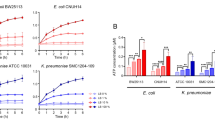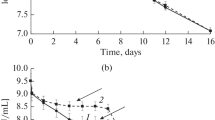Abstract
Bacterial persistence is the tolerance of a small part of a cell population to bactericidal agents, which is attained by a suppression of important cell functions and subsequent deceleration or cessation of cell division. The growth rate is the decisive factor in the transition of the cells to the persister state. A comparative study of quickly growing Escherichia coli K-12 strain MC 4100 and cyanobacteria Synechocystis sp. PCC 6803 and Anabaena variabilis ATCC 29413 growing slowly was performed. The cyanobacterial cells, like E. coli cells, differed in sensitivity to antimicrobial substances depending on the growth phase. Carbenicillin inhibiting the synthesis of peptidoglycan, a component of the bacterial cell wall, and lincomycin inhibiting the protein synthesis gave rise to nucleoid decay in cells from exponential cultures of Synechocystis 6803 and did not influence the nucleoids in cells from stationary cultures. Carbenicillin suppressed the growth of exponential cultures and had no effect on cyanobacterial stationary cultures. A suppression of Synechocystis 6803 growth in the exponential phase by lincomycin was stronger than in the stationary phase. Similar data were obtained with cyanobacterial cells under the action of H2O2 or menadione, an inducer of reactive oxygen species production. Slowly growing cyanobacteria were similar to quickly growing E. coli in their characteristics. Persistence is a characteristic feature of cyanobacteria.
Similar content being viewed by others
Abbreviations
- DAPI:
-
4′,6-diamidino-2-phenylindole
- PI:
-
propidium iodide
References
Bigger, J. W. (1944) Lancet, 11, 497–500 (cited by [2]).
Lewis, K. (2005) Biochemistry (Moscow), 70, 267–274.
Lewis, K. (2007) Nature Rev. Microbiol., 5, 48–56.
Keren, I., Shah, D., Spoering, A., Kaldalu, N., and Lewis, K. (2004) J. Bacteriol., 186, 8172–8180.
Spoering, A. L., and Lewis, K. (2001) J. Bacteriol., 183, 6746–6751.
Keren, I., Kaldalu, N., Spoering, A., Wang, Y., and Lewis, K. (2004) FEMS Microbiol. Lett., 230, 13–18.
Moyed, H. S., and Bertrand, K. P. (1983) J. Bacteriol., 155, 768–775.
Falla, T. Y., and Chopra, I. (1998) Antimicrob. Agents Chemother., 42, 3282–3284.
Pedersen, K., Christensen, S. K., and Gerdes, K. (2002) Mol. Microbiol., 45, 501–510.
Engelberg-Kulka, H., Sat, B., Reches, M., Amitai, S., and Hazan, R. (2004) Trends Microbiol., 12, 66–71.
Engelberg-Kulka, H., Hazan, R., and Amitai, S. (2005) J. Cell Sci., 118, 4327–4332.
LaFleur, M. D., Kumamoto, C. A., and Lewis, K. (2006) Antimicrob. Agents Chemother., 50, 3839–3846.
Rippka, R., Derulles, J., Waterbury, J. B., Herdman, M., and Stainer, R. Y. (1979) J. Gen. Microbiol., 181, 1–60.
Stocks, S. M. (2004) Cytometry, Pt. A 61A, 189–195.
Trotta, E., Del Grosso, N., Erba, M., Melino, S., Cicero, D., and Paci, M. (2003) Eur. J. Biochem., 270, 4755–4761.
Samuilov, V. D., Oleskin, A. V., and Lagunova, E. M. (2000) Biochemistry (Moscow), 65, 873–887.
Samuilov, V. D., Bezryadnov, D. V., Gusev, M. V., Kitashov, A. V., and Fedorenko, T. A. (2001) Biochemistry (Moscow), 66, 640–645.
Samuilov, V. D., Timofeev, K. N., Sinitsyn, S. V., and Bezryadnov, D. V. (2004) Biochemistry (Moscow), 69, 926–933.
Arkad’eva, Z. A. (1989) in Industrial Microbiology (Egorov, N. S., ed.) [in Russian] Vysshaya Shkola, Moscow, pp. 149–167.
Bukharin, O. V. (2006) Mikrobiol. Zh., No. 4, 4–8.
Costerton, J. W., Stewart, P. S., and Greenberg, E. P. (1999) Science, 284, 1318–1322.
Samuilov, V. D., Bezryadnov, D. V., Gusev, M. V., Kitashov, A. V., and Fedorenko, T. A. (1999) Biochemistry (Moscow), 64, 47–53.
Author information
Authors and Affiliations
Corresponding author
Additional information
Original Russian Text © V. D. Samuilov, A. V. Bulakhov, D. B. Kiselevsky, Yu. E. Kuznetsova, D. V. Molchanova, S. V. Sinitsyn, A. A. Shestak, 2008, published in Biokhimiya, 2008, Vol. 73, No. 7, pp. 1032–1038.
Rights and permissions
About this article
Cite this article
Samuilov, V.D., Bulakhov, A.V., Kiselevsky, D.B. et al. Tolerance to antimicrobial agents and persistence of Escherichia coli and cyanobacteria. Biochemistry Moscow 73, 833–838 (2008). https://doi.org/10.1134/S0006297908070122
Received:
Revised:
Published:
Issue Date:
DOI: https://doi.org/10.1134/S0006297908070122




